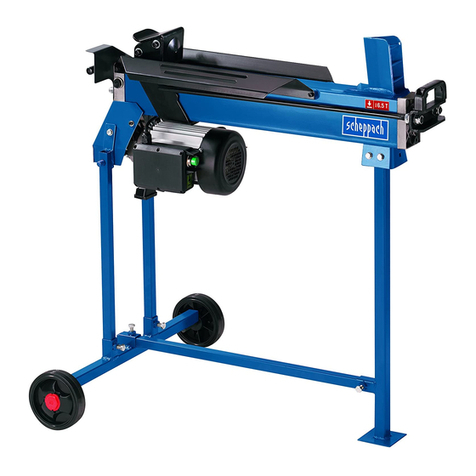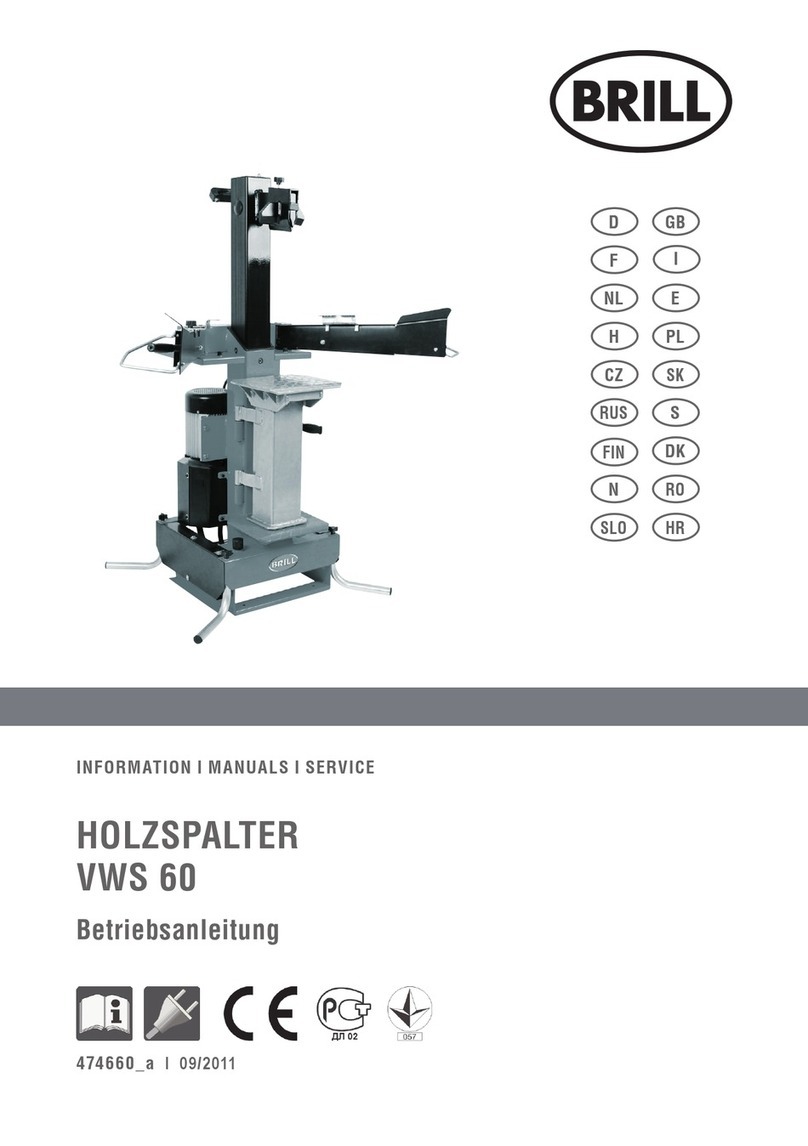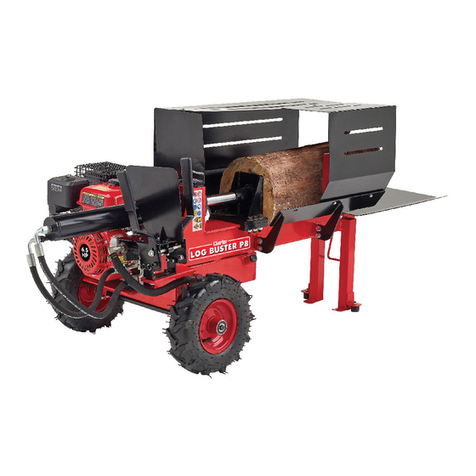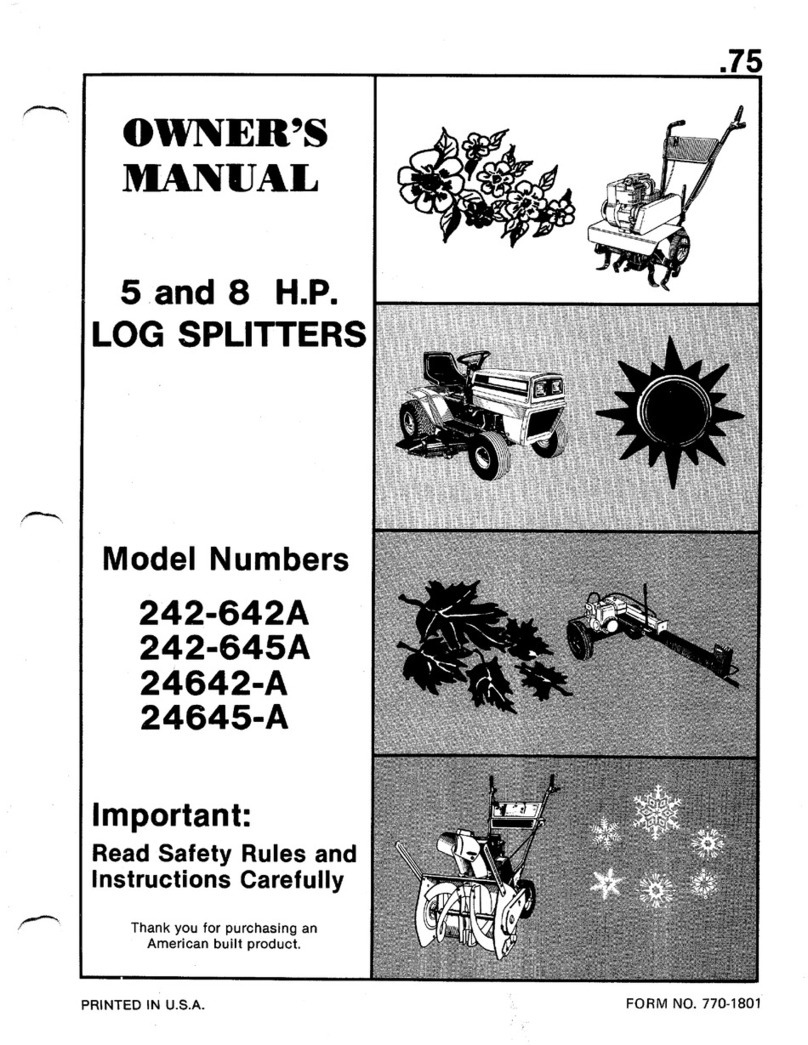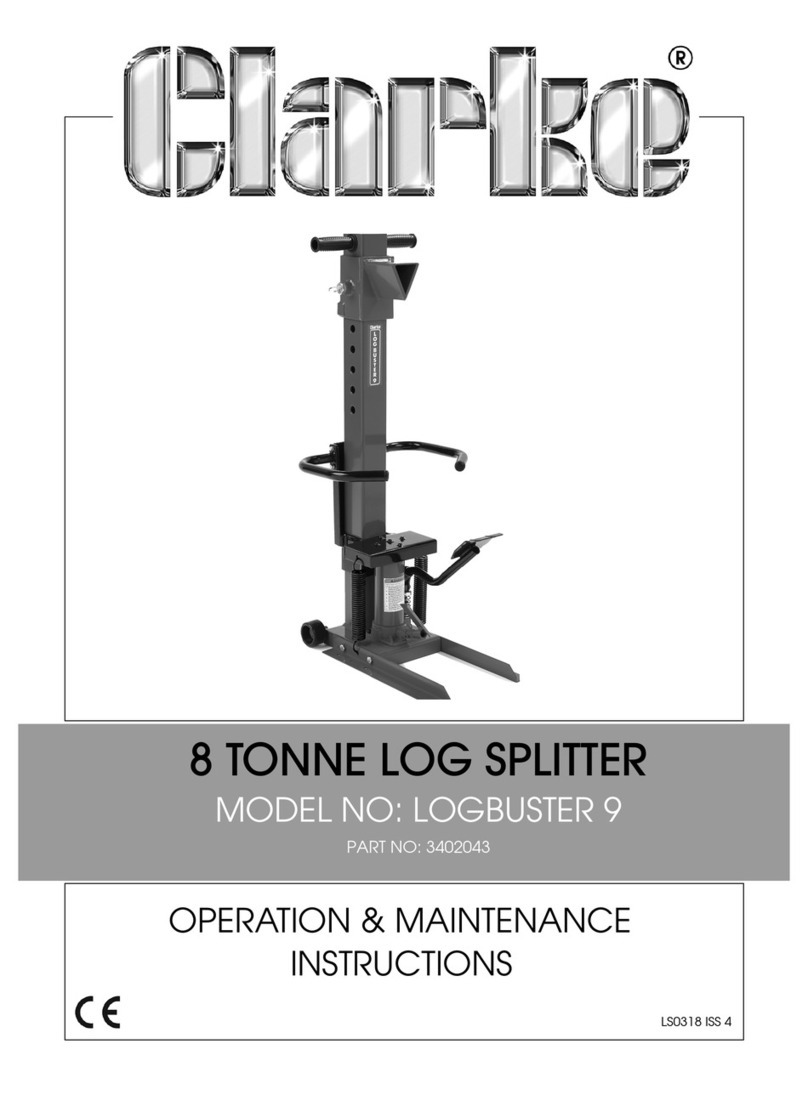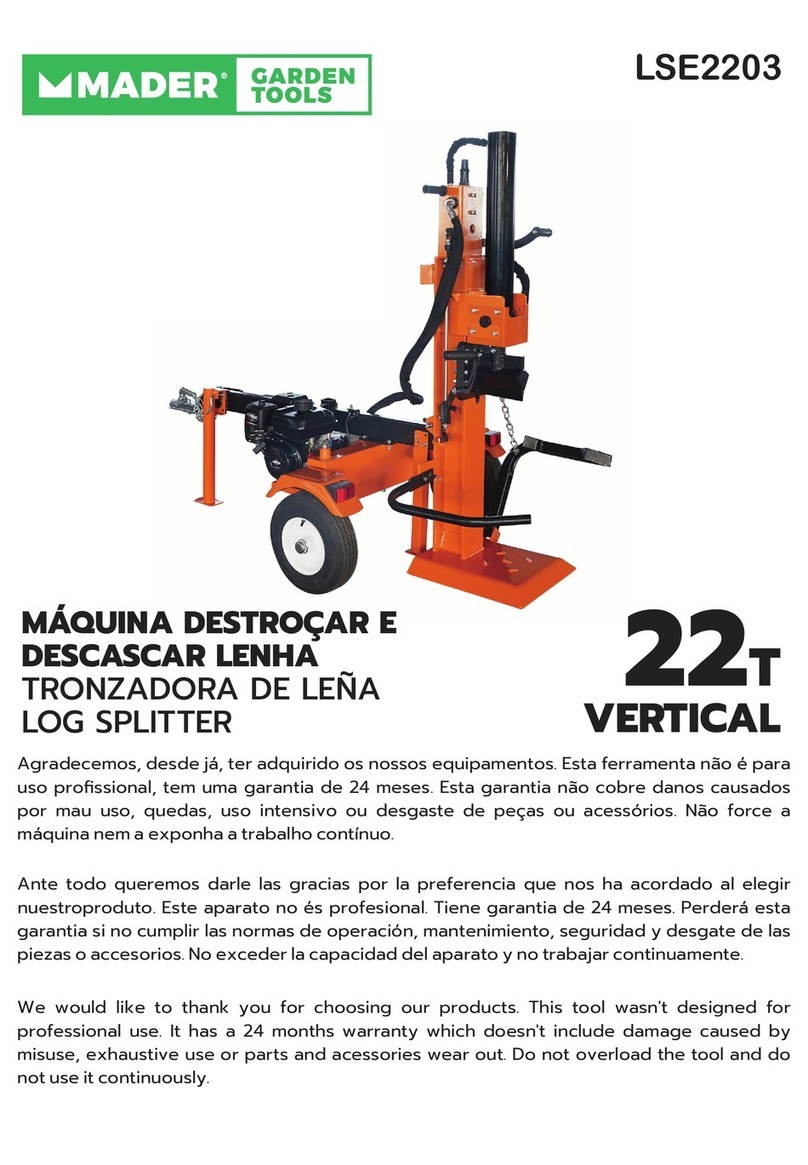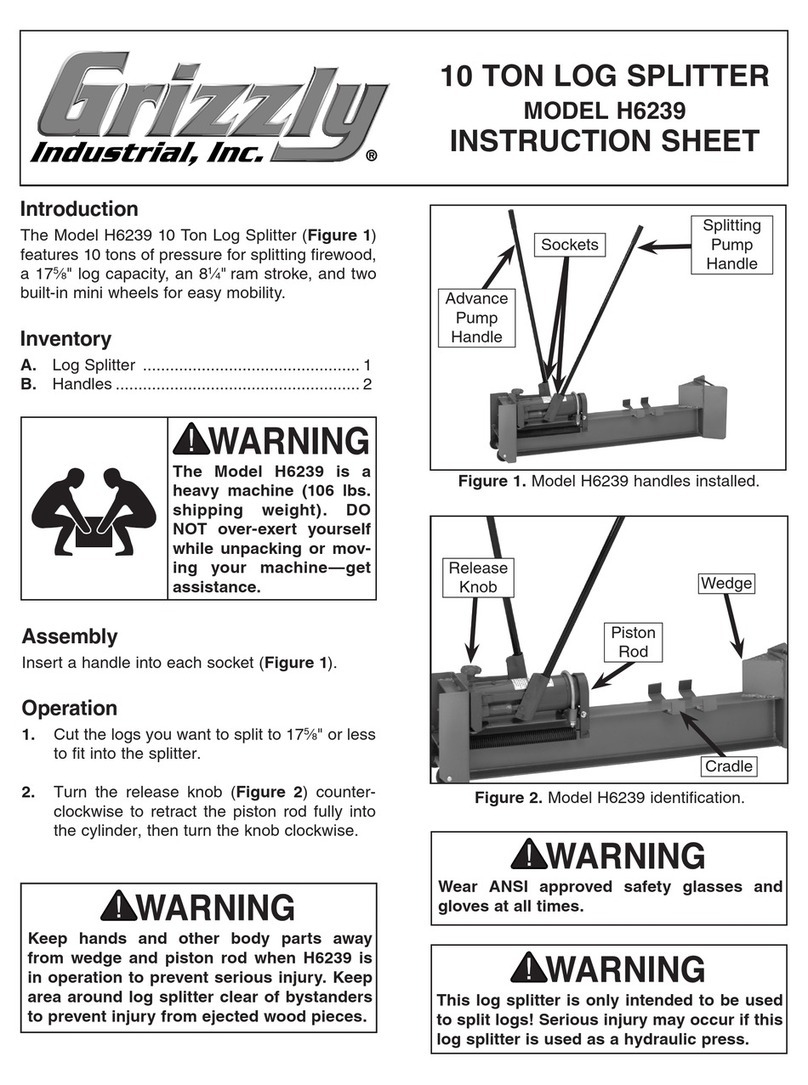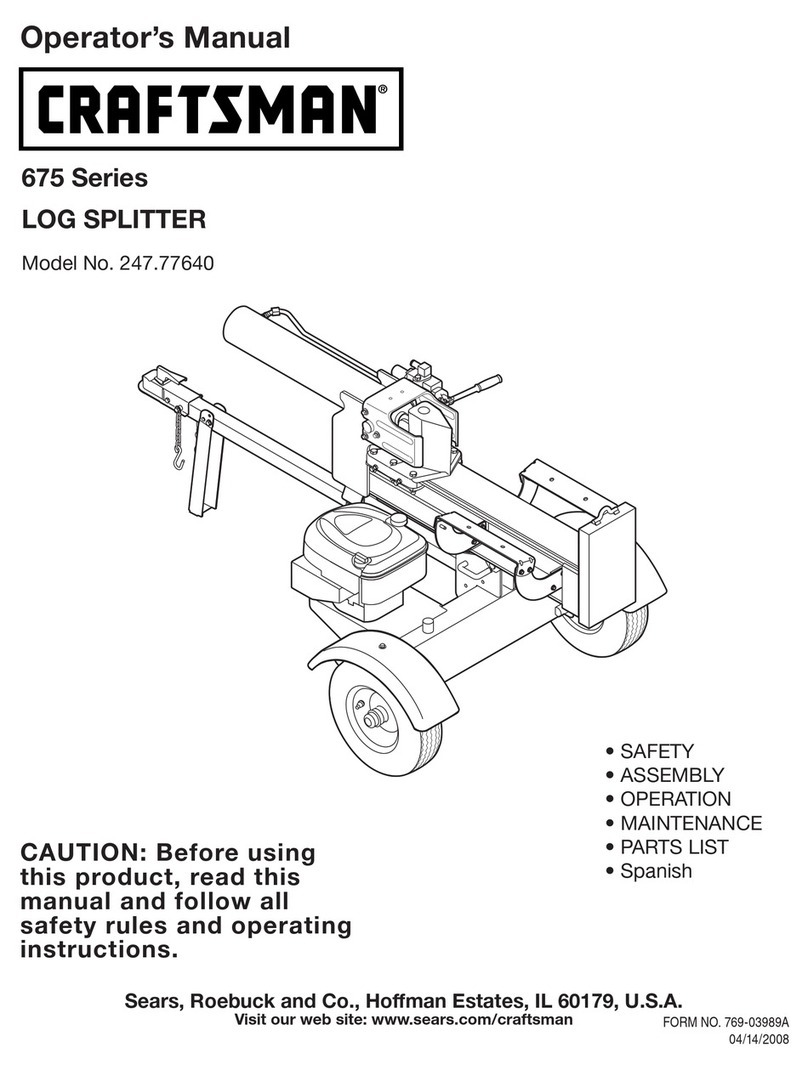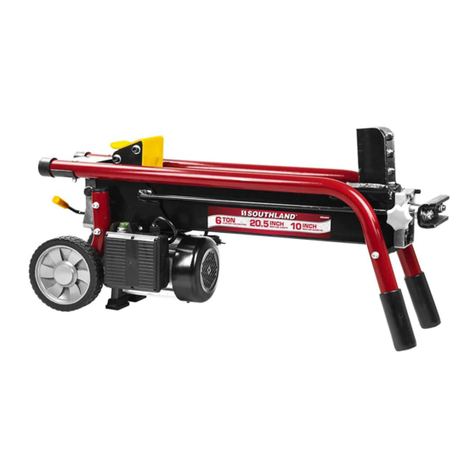Northern Tool + Equipment M11571GNEA User manual

Owner’s Manual
Instructions for Assembly, Testing, Operation,
Servicing, & Storage
Log Splitter: Outdoor hydraulic powered machine that
splits wood logs.
WARNING
READ and UNDERSTAND this manual completely before using log splitter.
All operators of this equipment must read and completely understand all safety information, operating instructions,
maintenance and storage instructions. Failure to properly operate and maintain the log splitter could result in serious
injury to the operator or bystanders from moving parts that can crush or cut, flying objects, burns, fire or explosion,
escaping high pressure hydraulic fluid, or carbon monoxide poisoning. In particular, be aware of the following
hazards: Crush and Cut Hazards
Moving parts can crush and cut hands and fingers. Keep hands clear of endplates, wedge, and logs while splitting.
High Pressure Hydraulic Fluid Hazards
High fluid pressures and temperatures are developed in hydraulic log splitters. Hydraulic fluid escaping through
even a pin-size hold opening can puncture skin and cause severe blood poisoning. Inspect hydraulic system
regularly for possible leaks. Never check for leaks with your hand while the system is pressurized. Seek medical
attention immediately if injured by escaping fluid. Fire Hazards
• If your log splitter is intended for use near any ignitable forest, brush, or grassy covered land, the engine exhaust
should be equipped with a spark arrestor.
• Keep a fire extinguisher with you, rated for ordinary combustibles and flammable liquids.
STOP!
ASSEMBLY REQUIRED: This product requires assembly before use. See “Assembly” section for instructions.
INSPECT COMPONENTS. Closely inspect upon receipt to make sure no components are missing or damaged. See
“Assembly” section for instructions on whom to contact to report missing or damaged parts.
ADD ENGINE OIL and HYDRAULIC OIL BEFORE USING: This product is shipped without engine oil or
hydraulic oil. DO NOT start log splitter before adding both oils. See “Assembly” and “Initial Unpacking & Set-
up” sections for detailed instructions.
Any Questions, Comments, Problems or Parts Orders
Call Product Support 1-866-443-2576
ITEM NUMBER: 11571GNE
SERIAL NUMBER: _______________
M11571GNEA

Hazard Signal Word Definitions
2

Table of Contents
3
About Your Log Splitter...........................................................................................................4
Safety Label Locations.............................................................................................................5
Machine Components Identification ........................................................................................6
Initial Set-up.............................................................................................................................7
Moving & Towing to the Job Site............................................................................................9
Before Each Use:
Step One: Inspection/Maintenance.................................................................................11
Step Two: Fueling ..........................................................................................................13
Step Three: Work site Selection & Set-up.....................................................................14
Splitting Operation ...................................................................................................................15
Storage......................................................................................................................................20
Periodic Maintenance...............................................................................................................21
Troubleshooting........................................................................................................................22
Specifications............................................................................................................................23
Parts Breakdown – Exploded View..........................................................................................24
Summary of Important Safety Information for Operation........................................................26
Assembly Instructions ..............................................................................................................31

About Your Log Splitter
4
Thank you for purchasing your log splitter!
About Your Log Splitter
This log splitter is a machine designed to split wood logs using a hydraulically powered moving wedge.
The gasoline-powered engine is used to pressurize the system.
This log splitter model is capable of splitting logs up to 24” long and 16” in diameter
This log splitter is designed to split logs lengthwise with the grain only.
This log splitter model is designed with a unique, timesaving feature -- a double-edged cutting wedge that
is capable of splitting wood on both the extension and retraction strokes of the wedge.
The technical specifications for your log splitter are provided in the “Specifications” section of this
manual.
WARNING
This log splitter uses a high-pressure hydraulic system to generate a very strong
splitting force. Read the manual completely before using the machine to understand
how to safely operate and maintain it.
Follow all safety precautions presented throughout this manual. A summary of important safety
information can be found at the end of the manual.
Contact Product Support at 1-866-443-2576 for any questions about the appropriate
use of this log splitter and/or optional accessories.
Warranty Registration:
Please fill out and submit the warranty registration card so that we may have your contact information for
any future product literature or replacement parts you may need.
Attention: All Rental Companies and Private Owners who
loan this equipment to others!
All persons to whom you rent/loan the log splitter must have access to and read this manual. Keep this
owner’s manual with the splitter at all times and advise all persons who will operate the machine to read
it. You must also provide personal instruction on how to safely operate the splitter and available to
answer any questions a renter/borrower might have.

Safety Label Location
5
Part # Description
781831 Splitter Warning / Instructions Decal
780187 Moving/Towing Decal
Always make sure safety labels are in place and in good condition. If a safety label is missing or not
legible, order new labels or unsafe operation could result.
WARNING
Equip engine with a spark arrestor if you will be using near ignitable
forest, brush or grassy covered land.
Keep a fire extinguisher on hand that is rated for ordinary combustibles
and flammable liquids.
High fluid pressures and temperatures are developed in the hydraulic
system.
Hydraulic fluid escaping through even a pin-size hole opening can
puncture skin and cause blood poisoning.
Hot exhaust can ignite dry brush, trees, or grass.
ESCAPING HIGH PRESSURE HYDRAULIC FLUID HAZARD
Log splitter exhaust contains carbon monoxide.
This is a poison you cannot see or smell.
Avoid other log splitter hazards.
READ MANUAL BEFORE USE.
Only use OUTSIDE and
far away from windows,
doors, and vents.
READ the Owner's Manual completely before
operating.
Only one person should operate the log splitter. If an assistant is helping
to load logs, the operator should not actuate controls until the assistant is
at least 10 ft away.
Stay in the designated OPERATOR POSITION while actuating the controls.
Split wood in direction of the grain only.
Hold bark side of logs when loading.
Keep hands away from wedge, endplates, and partly split logs.
Never leave log splitter unattended during operation.
Stay off slopes and slippery surfaces.
See additional safety rules in the Owner's Manual.
Inspect hydraulic system regularly for leaks.
Never check for leaks with your hand while system is pressurized.
Seek medical attention immediately if injured by escaping fluid.
©Northern Tool + Equipment Co. 1-866-443-2576
FIRE HAZARD
NEVER use inside a home
or garage. EVEN IF doors
and windows are open.
- Moving parts can crush and cut.
- Pieces can fly out while splitting.
- Follow safety rules for operatingthe log
splitter or serious injury could result.
DANGER
1. Retract wedge just enough to remove pressure between the log and endplate.
2. Turn engine OFF.
3. Remove stuck log from wedge manually with a pry baror sledgehammer.
Important: Be extremely careful as log pieces may fly off as they separate
from wedge.
Wear safety goggles and make sure bystanders are clear.
4. Do not attempt to resplit a stuck log once it has been removed from wedge.
GENERAL
Stay in the OPERATOR POSITION while actuating controls.
Never actuate controls until the helper is10ft away from log splitter, including
any helpers assisting to load logs.
Wear eye protection, hearing protection, snug fitting gloves,
& safety shoes or heavy boots. No loose or dangling
apparel.
OPERATING INSTRUCTIONS
SPLITTING LOG
Position log on beam, against endplate.
Move split control to extend wedge and split log.
Release split control to stop wedge.
Remove split wood from work area.
SETTING UP
Place log splitter on dry, level ground.
Secure splitter for unintended
movement.
Start engine.
PN 781831
ALWAYS remove the log MANUALLY using this procedure:
If this happens NEVER attempt to remove a stuck log by:
Using the hydraulic Modifying the Adding
force of the splitter splitter attachments
to the splitter
A log can become stuck to the wedge if the wedge becomes
embedded in the log and the log doesn't split and separate.
This can happen if the log is too stringy or tough tosplit
completely.
IF LOG BECOMES STUCK ON WEDGE
Personal injury could result from log or metal
pieces flying out at high speed toward the
operator or bystanders, or the splitter could
become damaged.

Machine Components Identification
6
1.) Log Table. This large log table keeps the log from falling on the ground after splitting. The
log table will keep the log on the beam without operator assistance.
2.) Beam/Cylinder. The hydraulic cylinder has a 4” bore and a 24” stroke, depending on model.
3.) Wedge. The wedge has two tapered edges that allow splitting in both directions. The wedge
features a taper that makes splitting easier.
4.) End Plate. The end plate keeps the log from moving as the wedge moves though the log.
5.) 2” Coupler. Allows the trailer unit to be hooked up to a 2” ball hitch.
6.) Safety Chains. Secures trailer to vehicle in case of accidental disconnection of ball and
coupler.
7.) Leg. The leg supports the log splitter while operating. The leg should be raised while towing
(see Operation Instructions).
8.) Lock. The locking pin locks the log to prevent unintended movement.
9.) Tires. The tires on this log splitter are for high speed towing (max 45mph).
10.) Hydraulic Tank. The hydraulic tank stores the hydraulic oil.
11.) Hydraulic Pump. The hydraulic pump makes the hydraulic oil flow through the system.
12.) Suction Strainer. The suction strainer removes debris from the hydraulic oil before entering
the pump.
13.) Engine. The air-cooled engine powers the hydraulic pump.
14.) Splitter Control Lever. Use the split control lever to move the wedge forward and
backward.

Initial Set-up
7
WARNING
Carefully read and follow all instructions for initial assembly and set-up of
this log splitter.
Failure to properly assemble and set up this equipment could result in serious
injury to the user or bystanders, or cause equipment damage.
Step One:
Assemble log splitter
Assemble your log splitter.
See the “Assembly” section of this manual – It will provide you with detailed instructions
on:
• Inspecting shipped components and whom to contact if anything is missing or
damaged.
• Assembly.
• Testing.
Step Two:
Add oil to engine Add oil to engine.
Using a funnel, add SAE 10W-30 oil up to the FULL mark on the dipstick. (See
engine Owner’s Manual for oil capacity and location of fill cap.)
Step Three:
Add Hydraulic Oil to
Reservoir
1. Remove hydraulic oil dipstick.
2. Refer to the Specifications section for approximate hydraulic oil capacity.
3. Fill reservoir with 10 wt AW32, ASLE H-150, or ISO 32 oil. Use a funnel
4. Replace hydraulic oil dipstick and check that oil level reads full.
5. Start engine and use split control lever to extend and retract wedge 5 (five) times
to remove air from the high pressure lines.
6. With wedge retracted, check oil level again. Fill if necessary.
Note: If the log splitter will be run for long periods of time in outdoor temperatures above
70°F, we recommend changing the hydraulic oil to DEXTRON III.
Step Four:
Check Hydraulic
system
Check the hydraulic system carefully:
1. Visually inspect all hoses, tubing, clamps/fittings, pump, and cylinder for cracks,
fraying, kinks, or other damage.
2. Check all components for oily residue, which may indicate a leak.
Do NOT operate the log splitter if there is any indication of damage or oily residue.
Small leaks in hydraulic lines can cause severe injuries and can also be an indication of
catastrophic failure in the near future. The life of hydraulic hoses may be from a few
months to a few years, depending on use and storage patterns.
WARNING: High fluid pressures and temperatures are developed in hydraulic
log splitters. Hydraulic fluid escaping through a pin hole sized opening can burn or
puncture skin, resulting in wounds that could cause blood poisoning, infection,
disability, gangrene, amputation, or death. Therefore, the following instructions
should be heeded at all times when inspecting or servicing the hydraulic
components of the log splitter:
• Stop the engine, disconnect the spark plug, and move the split control lever
back and forth to relieve pressure before changing or adjusting hydraulic
system components such as hoses, tubing, fittings or other components.

Initial Set-up
8
• NEVER check for leaks with your hand. Leaks can be located by holding a
piece of cardboard or wood (at least two feet long) with your hand at one end
and passing the other end over the suspected area (wear eye protection). Look
for discoloration of the cardboard or wood.
• NEVER adjust the pressure setting of the pump or valve.
• If injured by escaping fluid, no matter how small the wound is, see a doctor at
once. A typical injection injury may be a small puncture wound that does not
look serious. However, severe infection or reaction can result if proper
medical treatment is not administered immediately by a doctor who is familiar
with injection injuries.
WARNING: NEVER remove the hydraulic oil fill cap when the engine is
running or hot. Hot oil can escape causing severe burns. Allow log splitter to
cool completely before removing hydraulic oil fill cap.
Step Five:
Lubricate slide rail
beam
Lubricate wedge slide.
Extend the wedge slide as shown, and lubricate the surface of it with grease. This will
help prevent wear between the wedge slide and beam.

Moving & Towing to Job Site
9
WARNING
The log splitter is heavy. It can crush and cause serious injury if it rolls out of control or tips over.
Follow the instructions below for safely moving and towing the log splitter.
Moving the log splitter:
1. Engine off IMPORTANT: Ensure log splitter engine is off.
Never move the log splitter with its engine running
2. Fuel valve off Turn fuel valve off to prevent carburetor flooding and reduce the chance of fuel leakage.
3. Swing leg UP Lock the leg in the “UP” position before you move the log splitter anywhere by hand.
4. Move log splitter
to work site or tow
hitch
Move log splitter by hand either directly to chosen work site or to tow hitch for
towing.
(See “Before Each Use” section on selecting a work site)
Important Safety Instructions:
• Hills. Do not move the log splitter up or down hills by hand - use a towing
vehicle.
• No riding. Never allow anyone to sit or ride on the log splitter.
• No cargo. Never transport cargo or wood on the log splitter.
Towing:
1. Read instructions Review towing safety instructions in your vehicle manual.
2. Check tires Make sure tires are fully inflated and in good repair.
See tire sidewall for recommended tire pressure.
WARNING:
●Do not over-inflate tires. Serious injury can occur if tire explodes.
●When seating a bead after repair, do not exceed 30 PSI. Pressures higher than 30 PSI
can cause the tire and wheel to rupture and explode.
Swing leg
Pin Catch

Moving & Towing to Job Site
10
3. Swing leg UP Lock the leg in the “UP” position before you move the log splitter anywhere by hand.
4. Attach to hitch
(2” ball)
Attach Log Splitter to vehicle hitch.
1. Attach log splitter’s coupler to a class 2
or higher hitch with 2” ball (only).
2. Adjust coupler to ball by raising locking
lever and turning lock nut with fingers.
3. Proper adjustment is obtained when
coupler is as tight as possible on ball and
locking lever can still be opened and
closed.
4. Lock lever closed to secure the
attachment. An optional locking pin or
padlock may be inserted in the locking
lever hole for extra security.
5. Attach safety
chains Attach safety chains.
1. Two safety chains must be used while towing.
2. Cross safety chains under the coupler allowing only enough slack for vehicle turns.
6. Tow to desired
location Tow log splitter carefully to desired work site.
(See “Before Each Use” section on selecting an appropriate work site.)
Important safety instructions:
• Speed limit. Never tow this log splitter over 45 mph. Faster speeds may result in
loss of control.
• Added length. Be aware of the added length of the splitter.
• Rough terrain. Drive slowly and take extra caution when traveling over rough
terrain.
• On public roads. If towing on a public road, make sure to comply with all local,
state, and federal towing requirements. It is the sole responsibility of the
purchaser to obtain licensing, trailer lights, safety chains or signage, as needed to
comply.
• Unattended. Turn off the towing vehicle before leaving the splitter unattended.
• Under the influence. Never tow or operate this splitter while under the influence
of alcohol, drugs, or medication.
7. Lock leg down &
unhitch Lock tow bar leg in the DOWN position and unhitch from vehicle.
NEVER operate log splitter while it is attached to the vehicle.
Locking lever
(locked position)
Unlocked
position
Housin
g
Lock nut
Swing leg
Pin Catch

Before Each Use – Inspection / Maintenance
11
Step One: Inspect and maintain log splitter before each use.
If the log splitter has been used previously, it must be inspected and maintained BEFORE EACH SUBSEQUENT
USE.
WARNING
ALWAYS shut off the engine, disconnect the spark plug, and relieve system pressure before inspecting, cleaning,
adjusting, or repairing the splitter. Relieve system pressure by moving the split control lever back and forth several
times.
Important:
If a part needs replacement, only use parts that meet the manufacturer’s specifications. Replacement parts that do
not meet specifications may result in a safety hazard or poor operation of the log splitter.
1. Engine off / relieve
hydraulic pressure Perform all inspections/repairs with the engine off and hydraulic system
pressure relieved.
1. Make sure engine is off and cool.
2. Disconnect the spark plug
3. Relieve all hydraulic system pressure by moving the split control lever back and
forth several times.
2. Remove debris Remove debris from engine, muffler, and moving parts.
1. Engine debris.Debris on a hot engine can be a fire hazard. Clean debris and
chaff from engine cylinder head, cylinder head fins, blower housing rotating
screen, and muffler areas. Avoid contact with hot muffler.
2. Other debris. Debris on moving parts can cause excess wear. Clear debris from
the beam, wedge, and end plates.
3. Fuel tank / lines Check fuel tank and fuel lines for leaks.
Any fuel leak is a fire hazard. Fix any fuel leaks before starting engine.
4. Mechanical parts Check to be sure all nuts and bolts are tight to make sure the log splitter is in safe
working condition.
Extend wedge slide, and apply grease.
5. Hydraulic system Check the hydraulic system carefully:
1. Visually inspect all hoses, tubing, clamps/fittings, pump, and cylinder for cracks,
fraying, kinks, or other damage.
2. Check all components for oily residue, which may indicate a leak.

Before Each Use – Inspection / Maintenance
12
Do NOT operate the log splitter if there is any indication of damage or oily residue.
Small leaks in hydraulic lines can cause severe injuries and can also be an indication of
catastrophic failure in the near future. The life of hydraulic hoses may be from a few
months to a few years, depending on use and storage patterns.
WARNING: High fluid pressures and temperatures are developed in hydraulic
log splitters. Hydraulic fluid escaping through a pin hole sized opening can burn or
puncture skin, resulting in wounds that could cause blood poisoning, infection,
disability, gangrene, amputation, or death. Therefore, the following instructions
should be heeded at all times when inspecting or servicing the hydraulic
components of the log splitter:
• Stop the engine, disconnect the spark plug, and move the split control lever
back and forth to relieve pressure before changing or adjusting hydraulic
system components such as hoses, tubing, fittings or other components.
• NEVER check for leaks with your hand. Leaks can be located by holding a
piece of cardboard or wood (at least two feet long) with your hand at one end
and passing the other end over the suspected area (wear eye protection). Look
for discoloration of the cardboard or wood.
• NEVER adjust the pressure setting of the pump or valve.
• If injured by escaping fluid, no matter how small the wound is, see a doctor at
once. A typical injection injury may be a small puncture wound that does not
look serious. However, severe infection or reaction can result if proper
medical treatment is not administered immediately by a doctor who is familiar
with injection injuries.
6. Hydraulic oil level Check dipstick to make sure hydraulic oil level is to the fill line with cylinder
retracted. Fill as needed.
Note: Fill the tank with 10 wt AW32, ASLE H-150, or ISO 32 hydraulic oil. If the
log splitter will be run for long periods of time in outdoor temperatures above 70°F,
we recommend changing the hydraulic oil to DEXTRON III.
WARNING: NEVER remove the hydraulic oil fill cap when the engine is running or
hot. Hot oil can escape causing severe burns. Allow log splitter to cool completely
before removing hydraulic oil fill cap.
7. Engine Inspect and perform engine maintenance as directed in the engine manual.
8. Spark arrestor
muffler If the engine is equipped with a spark arrester muffler, clean and inspect it regularly
(follow spark arrestor manufacturer’s service instructions). Replace if damaged.
9. Tires Make sure tires are fully inflated and in good repair if you will be towing the
splitter.
See tire sidewall for recommended tire pressure.
WARNING:
• Do not over-inflate tires. Serious injury can occur if tire explodes.
• When seating a bead after repair, do not exceed 30 PSI. Pressures higher than 30
PSI can cause the tire and wheel to rupture and explode.
10. Shields / guards Replace all guards and shields after servicing the log splitter.

Before Each Use – Fueling
13
Step Two: Fueling
WARNING
Gasoline is highly flammable and explosive. You can be burned or seriously injured when
handling fuel. Use extreme care when handling gasoline.
1. Engine off / cool The engine must be off and allowed to cool at least two minutes before adding
fuel.
WARNING: A running engine is hot enough to ignite fuel. Never add fuel
or remove gas cap if engine is running or still hot.
2. Outdoor location Fill fuel tank outdoors – never indoors.
WARNING: Gasoline vapors can ignite if they collect inside an enclosure.
Explosion can result.
3. Remove gas cap Remove engine gas cap.
4. Add gasoline Add gasoline through fill opening from an UL-approved container.
Important Safety Instructions:
• Use approved container. NEVER pump fuel directly into engine at gas
station. Static charge can build and ignite fuel. Use a UL approved fuel
container to transfer gas to the engine.
• Don’t overfill. DO NOT overfill the gas tank. Allow at least 1/2” of empty
space below the fill neck to allow for fuel expansion
• Heat / flames / sparks. Stay away from sources of heat, flame, or sparks
while adding fuel.
5. Spills / splashes Clean up fuel spills /splashes immediately.
1. Move log splitter away from spilled fuel on the ground.
2. Wipe fuel off engine and wait 5 minutes for excess fuel to evaporate before
starting engine.
3. Gas soaked rags are flammable and should be disposed of properly.
4. If gasoline is spilled on your skin or clothes, change clothes and wash skin
immediately.
6. Replace gas cap Replace gas cap securely before starting engine.
7. Gasoline storage Store extra gasoline in a cool, dry place in an UL approved, tightly sealed
container.

Before Each Use – Work Site Selection & Set-Up
14
Step Three: Work site selection and log splitter set-up
WARNING
It is important to select an appropriate work site and properly set up the log splitter in order to minimize the risk of
slips and falls, equipment rolling or tipping over, carbon monoxide poisoning, and accidental fires.
1. Select location Select an appropriate location for operating the log splitter.
Requirements:
1. Dry, level surface with good footing. Stay clear of areas with mud, ice, tall grass,
weeds, or brush.
2. Outdoors, away from air intakes.
DANGER: The running engine gives off carbon monoxide, a poisonous gas that can
kill you. You CANNOT smell it, see it, or taste it.
• ONLY run log splitter OUTDOORS and away from air intakes. NEVER run log
splitter inside homes, garages, sheds, or other buildings or semi-enclosed spaces.
These spaces can trap poisonous gases, EVEN if you run a fan or open windows.
• If you start to feel sick, dizzy, or weak while using the log splitter, shut off the
engine and get to fresh air RIGHT AWAY. See a doctor. You may have carbon
monoxide poisoning.
2. Fire precautions Take the following precautions against fire:
1. IMPORTANT: If your splitter will be used near any unimproved forest, brush,
or grassy covered land, then engine must be equipped with a spark arrestor.
2. Make sure you comply with applicable local, state and federal codes.
3. Keep a fire extinguisher available (classified for both ordinary combustibles &
flammable liquids) as a precautionary measure when operating the log splitter in dry
areas.
3. Position 7’ from
any combustibles
or flammable
liquids
Position splitter at least 7 ft. from combustible objects during operation.
Hot exhaust fumes from splitter engine could cause fire. Also, hydraulic oil leaking or
spraying on hot engine can ignite.
4. Lock leg down Lock leg in the “DOWN” position.
5. Block Wheels Block wheels to prevent unintended movement of the log splitter.
Swing leg
Pin Catch

Splitting Operation
15
WARNING
Before starting the log splitter, review the following instructions and safety information for safe operation.
Failure to follow these rules may result in serious injury to the operator or bystanders from moving parts
that crush, cut, or entangle; from flying objects, burns, fire, falling or tripping; or from carbon monoxide
poisoning.
General safety information
• Read manual. Do not allow anyone to operate the log splitter who has not read the Owner’s Manual or has
not been instructed on the safe use of the splitter. The log splitter owner should instruct all operators in safe
log splitter operation.
• Age restrictions. Never allow anyone under 16 years old to operate the log splitter. Children 16 years and
older must be trained and supervised by a trained adult.
• Intended use. Log splitters should only be used for splitting wood logs, lengthwise with the grain. Do not
use for other purposes as unforeseen hazards may result.
• Modifications. Never modify or alter the log splitter in any way. Modifications can create serious safety
hazards and will void the warranty:
o Attachments. Never add attachments to the splitter, except for authorized accessories supplied by
the manufacturer with instructions for safe installation and use.
o Engine speed. The maximum engine speed is preset at a safe limit. Never attempt to modify the
engine speed setting to run at a higher speed.
o Fuel/exhaust system. NEVER modify or add to the exhaust system, fuel tanks, or fuel lines. Fire
can result.
o Remote control. NEVER attach a rope, cable, or other remote device to the splitting control.
o Splitting wedge. NEVER attempt to change the height or speed of the splitting wedge.
o Pressure setting. NEVER increase the pressure setting of the pump or control valve.
• Safety equipment / controls. Always operate the log splitter with all safety equipment in place and in good
working order, and all controls properly adjusted for safe operation.
• Know how to stop. Be thoroughly familiar with all controls and with the proper use of the equipment.
Know how to stop the log splitter and relieve system pressures quickly if needed.
• Operating speed. Always operate the log splitter at the manufacturer’s recommended speed. The
maximum speed of the engine, pump and wedge are preset within safe limits.
• Daylight only. Only use the log splitter in daylight so you can see what you are doing.
• Smoking / sparks. Never smoke while operating the log splitter, and never operate near sources of sparks
or flames.
• Under the influence. Never operate, or let anyone else operate, the log splitter while under the influence of
alcohol, drugs, or medication.
• Unattended. Never leave the machine unattended while the engine is running.
• Refueling. Never refuel the engine until it has cooled at least two minutes.
• Adjusting / repairing. Always make sure the engine is off before cleaning, repairing or adjusting the
splitter, except as recommended by the manufacturer. In addition, disconnect the spark plug and move all
control handles back and forth to relieve system pressure before changing or adjusting hydraulic system
components such as hoses, tubing, fittings or other components.
• Replace labels. Always make sure safety labels are in place and in good condition. If a safety label is
missing or not legible, order new labels because unsafe operation can result. Call 1-866-443-2576 to order
new safety labels.

Splitting Operation
16
1. Put on protective
clothing / gear Wear the following protective clothing and safety gear.
1) Eye protection. Always wear safety glasses or goggles when operating the machine.
Pieces of log may fly out and serious eye injury can occur
2) Boots. Falling logs can crush feet. Always wear safety shoes or heavy boots when
operating or helping to load logs.
3) Gloves. Wear snug fitting gloves without drawstrings or loose cuffs.
4) Hearing protection. The use of earplugs or other hearing protection device is
recommended. Applications
5) No Loose / dangling apparel. Loose or dangling apparel can become entangled in
moving parts. Never wear jewelry or loose-fitting clothing
2. Lock & block Secure log splitter from unintended movement. Check that:
1) The tow bar leg is locked in the DOWN position.
2) The wheels are blocked.
3. Start engine Start the engine.
See the engine owner’s manual for engine starting instructions.
Note:
a) Make sure the hydraulic oil is above 10oF before starting the engine. Cold
hydraulic oil can damage the hydraulic pump.
b) If outdoor air temperature is below 32oF, allow log splitter to warm up by
extending and returning the wedge several times before splitting wood.
WARNING:
Burns. To avoid burns, stay clear of hot muffler if you are starting a warm engine.
Carbon monoxide. The running engine gives off carbon monoxide, a poisonous
gas that can kill you. You CANNOT smell it, see it, or taste it. If you start to feel
sick, dizzy, or weak while using the log splitter, shut off the engine and get to
fresh air RIGHT AWAY. See a doctor. You may have carbon monoxide
poisoning.
Other exhaust dangers. Engine exhaust, some of its constituents, and certain
vehicle components contain or emit chemicals known to the State of California to
cause cancer, birth defects, or other reproductive harm. Avoid inhalation of
exhaust.
4. Load log Load log onto beam between the wedge and an endplate, cut edge against the
endplate - positioned for a lengthwise cut.
Notes:
a) This log splitter is equipped with a unique double-edged cutting wedge, which is
capable of splitting wood on either the extension or retraction stroke of the
wedge.
b) The log splitter is designed only for cutting lengthwise with the grain, NOT for
cutting across the grain.
c) This log splitter is designed for cutting logs only up to 24” long and 16” in
diameter, lengthwise with the grain only. Larger diameter logs could get stuck on
the wedge and longer logs will not fit on the beam.

Splitting Operation
17
FIG02218
WARNING: ALWAYS keep hands and feet away from the wedge and partially
split logs while loading, operating and unloading the log splitter.
Important safety instructions:
• Hold bark side. Hold the bark side of logs when loading or positioning, never
the ends. Never place your hands or any part of your body between a log and
any part of the log splitter.
• Wedge moving. NEVER load or unload logs while the wedge is moving.
• Straddling / reaching across. Never straddle, reach across, or step over the
beam while the engine is running. You could trip, actuate the controls, and get
seriously injured.
• Unsplit log pile. Do not pile logs to be split in a place that will make you reach
across the log splitter in order to load them.
• Square log ends. Logs that are not cut square can slide out while splitting and
become a safety hazard or cause excessive force to log splitter components. Use
a chainsaw to cut logs square on each end before attempting to split them.
• Single log. Never attempt to split more than one log at a time. Pieces of log can
unexpectedly be thrown from the machine causing serious injury.
• Split along grain. Do not use the log splitter to split logs across the grain.
Doing so will damage the log splitter and could also cause pieces of log to be
thrown, injuring the operator or bystanders
5. Extend wedge Move Split Control Lever toward the end plate to move the wedge and split the log.
Correct
Log Orientation Incorrect
Log Orientation
Split Log Split Log
N
SPLIT CONTROL

Splitting Operation
18
Important safety instructions:
• Operator position. ALWAYS operate the log splitter from the manufacturer’s
indicated OPERATOR POSITION. (See diagram above.) Other positions are
unsafe because they can increase the risk of injury from crushing, cutting, flying
objects, or burns.
• Remove hands. Remove both hands from log before activating the split control
lever.
• Hand activate. Use only your hand to operate the Split Control Lever. Never
use any other body part, or a rope, cable, or other remote device to actuate the
control.
• Second person. Many accidents occur when there is more than one person
involved in loading and operating the log splitter. Only one person should
operate the controls. If a second person is assisting in loading logs, the operator
must NEVER actuate the split control lever until the assistant and all bystanders
are at least 10 feet away. NEVER allow an assistant to hold the log in place
while the operator actuates the Split Control Lever.
6. Stop wedge Release Split Control Lever to stop wedge movement when log is split.
WARNING: Cracks in logs can close quickly and pinch fingers. Keep fingers away
from any cracks that open in partially split logs.
Split Log Split Log
N
SPLIT CONTROL

Splitting Operation
19
7. Important
STUCK LOG
procedure
If a log does not split completely and becomes stuck on the wedge, follow the
instructions below to remove the log.
A log can become stuck to the wedge if the wedge becomes embedded in the log and the
log doesn’t split and separate. This can happen if the log is too stringy or tough to split
completely.
If this happens, follow the directions below.
WARNING: NEVER attempt to remove a stuck log by:
• Using the hydraulic force of the splitter
• Modifying the splitter
• Adding attachments to the splitter
Personal injury could result from log or metal pieces flying out at high speed toward
the operator or bystanders, or the splitter could become damaged.
1. Remove pressure from log by moving wedge away from the endplate.
2. Turn engine OFF.
3. Remove stuck log from the wedge manually with a pry bar or a sledgehammer.
Important: Be extremely careful as log pieces may fly off as they separate
from the wedge. Make sure bystanders are clear and wear safety goggles.
4. Do not attempt to resplit a stuck log once it has been removed from the wedge.
Manually split with an axe or cut with a chainsaw.
8. Remove split
wood Move each log away from log splitter after it is split. Split logs left near the log
splitter are a trip hazard.
9. After use 1. Turn off engine.
2. Remove engine debris.
Debris on a hot engine can be a fire hazard. After the engine is off, clean debris and
chaff from engine cylinder head, cylinder head fins, blower housing rotating screen,
and muffler areas.
WARNING: Avoid contact with hot muffler.
Any Questions, Comments, Problems or Parts Orders
Call Product Support 1-866-443-2576

Storage
20
WARNING
Gasoline vapors can ignite and cause a fire. Select a well-ventilated storage area away from sources of
heat, flame, or sparks.
Follow the instructions below for storing your log splitter between uses:
1. Retract cylinder Retract the wedge completely to the hitch end of the log splitter to keep the rod
protected from corrosion.
2. Cool Allow the machine to cool 5 minutes before storing.
WARNING: A hot engine can be a fire hazard.
3. Wipe with oily rag Wipe the wedge with an oily rag to prevent corrosion.
4. Engine manual Refer to the engine manual for proper engine storage instructions.
CAUTION: Gasoline will oxidize and deteriorate in storage. Old gasoline in the
engine will cause hard starting and leave gum deposits that can clog the fuel
system. Deterioration problems may occur within a few months, or even less if
gasoline was not fresh when you filled the fuel tank.
Short-Term Storage:
1. Consider adding a fuel stabilizer to extend fuel storage life.
2. Leave the fuel valve lever in the OFF position to reduce the possibility of fuel
leakage.
Long Term Storage: (between infrequent uses and at end of season)
Drain the fuel tank and carburetor as instructed in the engine owner’s manual.
Important Safety Instructions:
• Always drain fuel from tank in outdoor, well-ventilated area.
• Stay away from sources of heat, flame, or sparks while handling fuel.
• Clean up fuel spills/splashes immediately.
5. Splitter storage
location Store the log splitter in a location away from corrosive material, sources of heat,
open flames, sparks or pilot lights.
WARNING: Never store log splitter inside where there is a source of heat or an
open flame, spark, or pilot light – such as water heaters, space heaters, furnaces,
clothes dryers, or other gas appliances. Even if the log splitter’s gas tank is empty,
residual gasoline vapors could ignite.
NOTE: Do not store the log splitter near fertilizer or any other corrosive material.
6. Gasoline storage Store gasoline in a cool, dry place in an UL approved, tightly sealed container.
WARNING: Gasoline vapors can ignite if they collect inside an enclosure and
explosion can result.
Table of contents
Other Northern Tool + Equipment Log Splitter manuals
Popular Log Splitter manuals by other brands
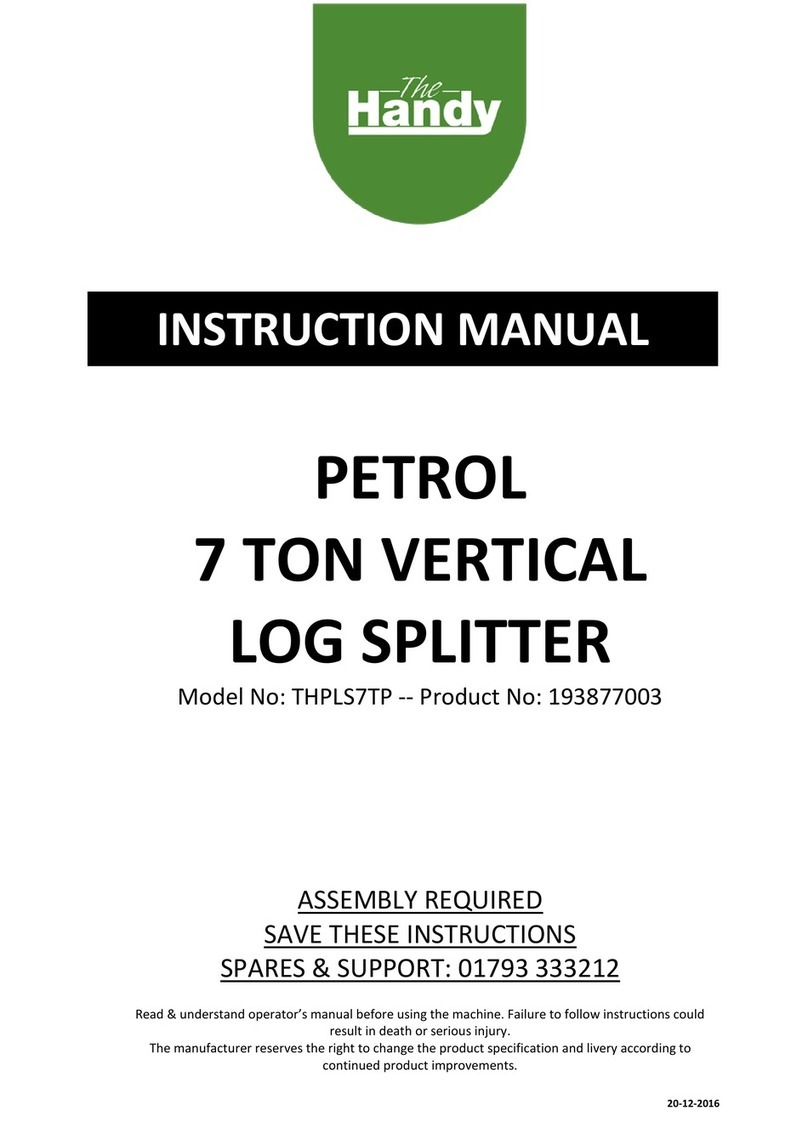
The Handy
The Handy THPLS7TP instruction manual

Wallenstein
Wallenstein 3652A300 installation instructions
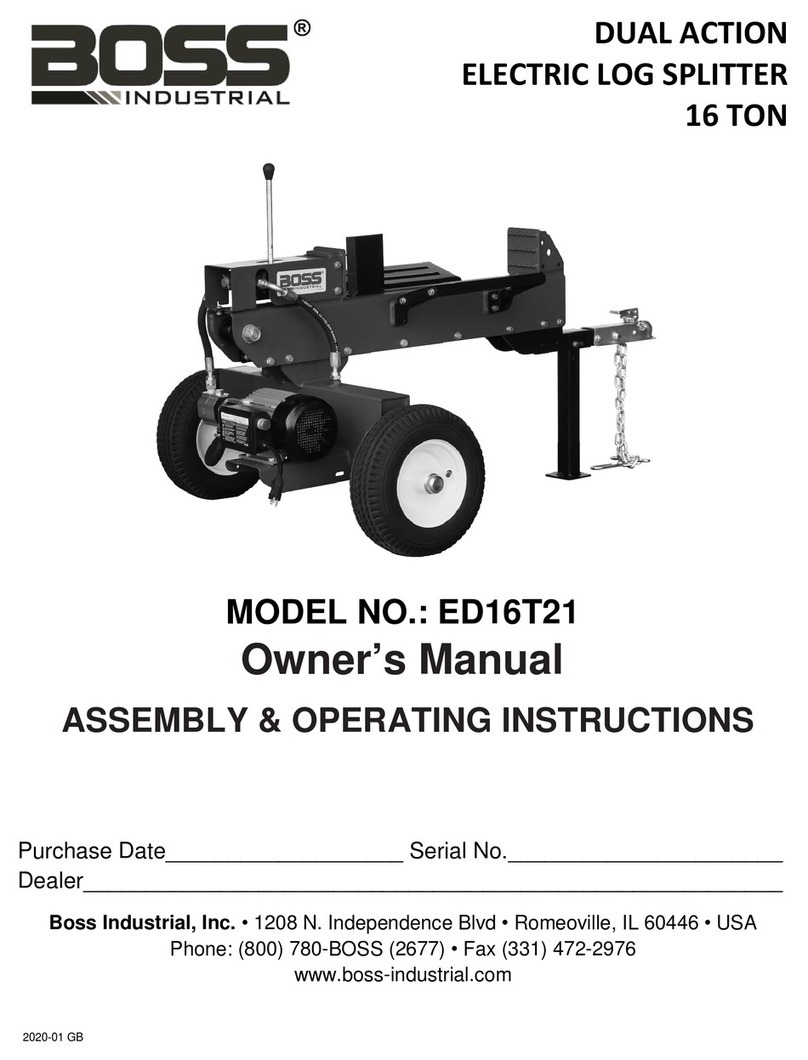
Boss Industrial
Boss Industrial ED16T21 Owners manual assembly & operating instructions
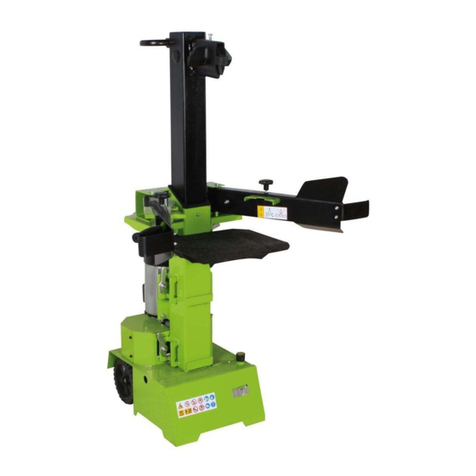
Zipper Mowers
Zipper Mowers ZI-HS8 manual

Champion Power Equipment
Champion Power Equipment 92251-1 owner's manual

Central Hydraulics
Central Hydraulics 91839 Set up and operating instructions

